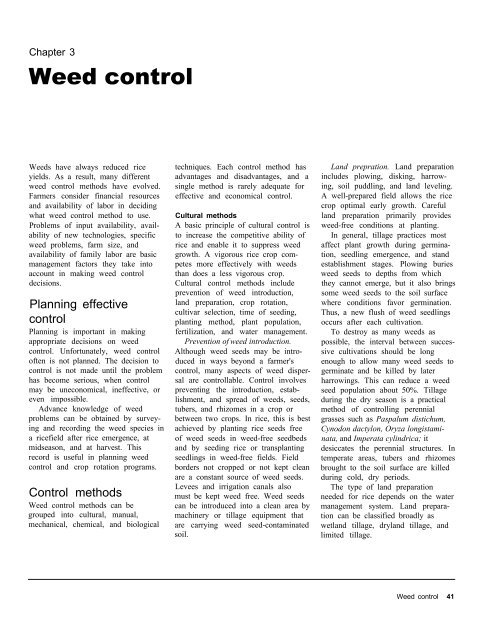A handbbok on Weed Control in Rice.pdf
A handbbok on Weed Control in Rice.pdf
A handbbok on Weed Control in Rice.pdf
Create successful ePaper yourself
Turn your PDF publications into a flip-book with our unique Google optimized e-Paper software.
Chapter 3<br />
<strong>Weed</strong> c<strong>on</strong>trol<br />
<strong>Weed</strong>s have always reduced rice<br />
yields. As a result, many different<br />
weed c<strong>on</strong>trol methods have evolved.<br />
Farmers c<strong>on</strong>sider f<strong>in</strong>ancial resources<br />
and availability of labor <strong>in</strong> decid<strong>in</strong>g<br />
what weed c<strong>on</strong>trol method to use.<br />
Problems of <strong>in</strong>put availability, avail-<br />
ability of new technologies, specific<br />
weed problems, farm size, and<br />
availability of family labor are basic<br />
management factors they take <strong>in</strong>to<br />
account <strong>in</strong> mak<strong>in</strong>g weed c<strong>on</strong>trol<br />
decisi<strong>on</strong>s.<br />
Plann<strong>in</strong>g effective<br />
c<strong>on</strong>trol<br />
Plann<strong>in</strong>g is important <strong>in</strong> mak<strong>in</strong>g<br />
appropriate decisi<strong>on</strong>s <strong>on</strong> weed<br />
c<strong>on</strong>trol. Unfortunately, weed c<strong>on</strong>trol<br />
often is not planned. The decisi<strong>on</strong> to<br />
c<strong>on</strong>trol is not made until the problem<br />
has become serious, when c<strong>on</strong>trol<br />
may be unec<strong>on</strong>omical, <strong>in</strong>effective, or<br />
even impossible.<br />
Advance knowledge of weed<br />
problems can be obta<strong>in</strong>ed by survey-<br />
<strong>in</strong>g and record<strong>in</strong>g the weed species <strong>in</strong><br />
a ricefield after rice emergence, at<br />
midseas<strong>on</strong>, and at harvest. This<br />
record is useful <strong>in</strong> plann<strong>in</strong>g weed<br />
c<strong>on</strong>trol and crop rotati<strong>on</strong> programs.<br />
C<strong>on</strong>trol methods<br />
<strong>Weed</strong> c<strong>on</strong>trol methods can be<br />
grouped <strong>in</strong>to cultural, manual,<br />
mechanical, chemical, and biological<br />
techniques. Each c<strong>on</strong>trol method has<br />
advantages and disadvantages, and a<br />
s<strong>in</strong>gle method is rarely adequate for<br />
effective and ec<strong>on</strong>omical c<strong>on</strong>trol.<br />
Cultural methods<br />
A basic pr<strong>in</strong>ciple of cultural c<strong>on</strong>trol is<br />
to <strong>in</strong>crease the competitive ability of<br />
rice and enable it to suppress weed<br />
growth. A vigorous rice crop com-<br />
petes more effectively with weeds<br />
than does a less vigorous crop.<br />
Cultural c<strong>on</strong>trol methods <strong>in</strong>clude<br />
preventi<strong>on</strong> of weed <strong>in</strong>troducti<strong>on</strong>,<br />
land preparati<strong>on</strong>, crop rotati<strong>on</strong>,<br />
cultivar selecti<strong>on</strong>, time of seed<strong>in</strong>g,<br />
plant<strong>in</strong>g method, plant populati<strong>on</strong>,<br />
fertilizati<strong>on</strong>, and water management.<br />
Preventi<strong>on</strong> of weed <strong>in</strong>troducti<strong>on</strong>.<br />
Although weed seeds may be <strong>in</strong>tro-<br />
duced <strong>in</strong> ways bey<strong>on</strong>d a farmer's<br />
c<strong>on</strong>trol, many aspects of weed disper-<br />
sal are c<strong>on</strong>trollable. C<strong>on</strong>trol <strong>in</strong>volves<br />
prevent<strong>in</strong>g the <strong>in</strong>troducti<strong>on</strong>, estab-<br />
lishment, and spread of weeds, seeds,<br />
tubers, and rhizomes <strong>in</strong> a crop or<br />
between two crops. In rice, this is best<br />
achieved by plant<strong>in</strong>g rice seeds free<br />
of weed seeds <strong>in</strong> weed-free seedbeds<br />
and by seed<strong>in</strong>g rice or transplant<strong>in</strong>g<br />
seedl<strong>in</strong>gs <strong>in</strong> weed-free fields. Field<br />
borders not cropped or not kept clean<br />
are a c<strong>on</strong>stant source of weed seeds.<br />
Levees and irrigati<strong>on</strong> canals also<br />
must be kept weed free. <strong>Weed</strong> seeds<br />
can be <strong>in</strong>troduced <strong>in</strong>to a clean area by<br />
mach<strong>in</strong>ery or tillage equipment that<br />
are carry<strong>in</strong>g weed seed-c<strong>on</strong>tam<strong>in</strong>ated<br />
soil.<br />
Land preprati<strong>on</strong>. Land preparati<strong>on</strong><br />
<strong>in</strong>cludes plow<strong>in</strong>g, disk<strong>in</strong>g, harrow<strong>in</strong>g,<br />
soil puddl<strong>in</strong>g, and land level<strong>in</strong>g.<br />
A well-prepared field allows the rice<br />
crop optimal early growth. Careful<br />
land preparati<strong>on</strong> primarily provides<br />
weed-free c<strong>on</strong>diti<strong>on</strong>s at plant<strong>in</strong>g.<br />
In general, tillage practices most<br />
affect plant growth dur<strong>in</strong>g germ<strong>in</strong>ati<strong>on</strong>,<br />
seedl<strong>in</strong>g emergence, and stand<br />
establishment stages. Plow<strong>in</strong>g buries<br />
weed seeds to depths from which<br />
they cannot emerge, but it also br<strong>in</strong>gs<br />
some weed seeds to the soil surface<br />
where c<strong>on</strong>diti<strong>on</strong>s favor germ<strong>in</strong>ati<strong>on</strong>.<br />
Thus, a new flush of weed seedl<strong>in</strong>gs<br />
occurs after each cultivati<strong>on</strong>.<br />
To destroy as many weeds as<br />
possible, the <strong>in</strong>terval between successive<br />
cultivati<strong>on</strong>s should be l<strong>on</strong>g<br />
enough to allow many weed seeds to<br />
germ<strong>in</strong>ate and be killed by later<br />
harrow<strong>in</strong>gs. This can reduce a weed<br />
seed populati<strong>on</strong> about 50%. Tillage<br />
dur<strong>in</strong>g the dry seas<strong>on</strong> is a practical<br />
method of c<strong>on</strong>troll<strong>in</strong>g perennial<br />
grasses such as Paspalum distichum,<br />
Cynod<strong>on</strong> dactyl<strong>on</strong>, Oryza l<strong>on</strong>gistam<strong>in</strong>ata,<br />
and Imperata cyl<strong>in</strong>drica; it<br />
desiccates the perennial structures. In<br />
temperate areas, tubers and rhizomes<br />
brought to the soil surface are killed<br />
dur<strong>in</strong>g cold, dry periods.<br />
The type of land preparati<strong>on</strong><br />
needed for rice depends <strong>on</strong> the water<br />
management system. Land prepara-<br />
ti<strong>on</strong> can be classified broadly as<br />
wetland tillage, dryland tillage, and<br />
limited tillage.<br />
<strong>Weed</strong> c<strong>on</strong>trol 41











